The Heroine’s Journey in Captain Marvel (2019 film)
The twenty-first film in the Marvel Cinematic Universe, Captain Marvel (2019) was the first with a woman in the role of titular lead character. That inexcusable delay was attributable primarily to power dynamics within Marvel’s corporate structure: prior to 2015, overall Marvel Entertainment chairman Ike Perlmutter (who soon after took on a prominent role for the Trump administration) used his authority to block any rise to prominence for female characters in the movies, or even their associated toys. In the summer of that year, though, Kevin Feige successfully maneuvered Marvel Studios under a new chain of command, reporting instead to Walt Disney Studios chairman Alan Horn and Disney CEO Bob Iger. Since then, the rapid increase in diversity and inclusion in the MCU, both on screen and in the creative teams, has been deliberate and substantial. With both Black Panther and Captain Marvel grossing over one billion dollars at the global box office in consecutive springs, the financial incentives to continue in that direction have only increased.
Given its place in the production timeline, Feige and his team rightly decided that the MCU did not need another “hero gets powers” origin story. Like Spider-Man: Homecoming and Black Panther the preceding years, Captain Marvel does not focus on the protagonist discovering the powers that enable her to be a superhero, but rather on discovering her identity as a superhero – most importantly, deciding on the kind of superhero she wants to be. In this way, Captain Marvel also resembles DC’s Wonder Woman (2017), in which Diana is already fully powered when she leaves Themyscira and instead experiences a Heroine’s Journey of deciding who and what she will fight for in the war-torn world of men she finds beyond that mystical realm.
The arc of Carol Danvers in Captain Marvel takes the elements of a Heroine’s Journey and combines them with a mystery: her journey is not simply the usual one of metaphorical self-discovery, but in the literal sense of piercing her amnesia. Feige and others have described this storyline as inspired by Robocop, another film in which the titular character recognizes, and then overcomes, the manipulations and deceit of those he served. Together, the audience and Carol slowly learn the truth of her backstory, and those revelations force her to decide who she is going to become in the present.
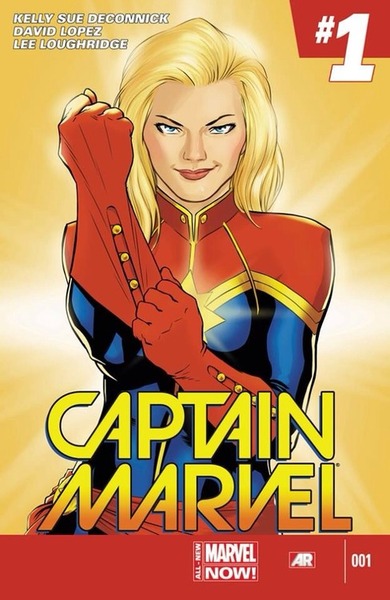
The crafting of Captain Marvel’s Heroine’s Journey is unusual for Hollywood because it relies entirely on women’s perspectives in its creative origin. Carol Danvers is not a new character in the Marvel comics, with stories (written and drawn by men) beginning in the late 1960s. But the recent iteration of Carol Danvers, taking on the mantle of Captain Marvel as devised and written by Kelly Sue DeConnick from 2012 to 2015, served as direct inspiration for the movie. The film does not adapt a particular storyline from DeConnick’s comics, but the characterization and motivations – and the emphasis on giving Carol agency in the story – are instantly recognizable. The movie’s “story by” credits, reflecting earlier drafts in the development process, include Nicole Perlman and Meg LeFauve; the “screenplay by” credits are Geneva Robertson-Dworet together with the co-directing team of Anna Boden and Ryan Fleck.
The traits displayed by Carol during her Heroine’s Journey arise directly from this creative background. In their introduction to the movie on the Blu-ray edition, Boden and Fleck describe Carol’s characterization in the film as emphasizing “compassion and vulnerability.” Throughout her transition from Kree StarForce warrior to Captain Marvel superheroine, her primary motivation is protecting others. She may have superpowers and Kree blood in her veins, but Carol remains deeply in touch with her humanity. She can be impulsive, such as when she uses her powers to overheat the restraints on her hands – only to blast a hole in the hull of the starship, too. She is an adrenaline junkie, reveling in the thrill of flying – and fighting. As a whole, Carol is neither fully a nurturing hero nor a conquering hero; she has significant aspects of both.
Similarly, Carol’s story draws heavily on themes common to many Heroine’s Journey tales. She has been taught that she must follow rules imposed on her by others; part of her path is learning that she should break those rules and determine her own. She can walk a fine line between humility and self-doubt, with the latter often arising when she feels the weight of those external rules holding her back. In the Heroine’s Journey model developed by Maureen Murdock as an alternative to the famous Hero’s Journey from the work of Joseph Campbell, the heroine’s progression centers on reconciling the feminine and the masculine forces in her life, at first with them separated and in conflict, but ultimately healing them both into a unity rather than a duality. In Captain Marvel, the Kree side of Carol represents the masculine, especially Yon-Rogg and the values he seeks to instill in her, while her connection to Earth represents the feminine, particularly her bond with Maria Rambeau and her mentorship by Lawson/Mar-Vell. Over the course of the movie, Carol integrates these two sides of herself into something new, and becomes her own woman – her own superheroine – in the process.
With all this in mind, it is unsurprising that the story beats in Captain Marvel have much more in common with the modern cinematic version of the Hero’s Journey developed by Christopher Vogler than the historically oriented monomyth of Campbell derived from centuries of patriarchal legends. In many familiar movies based around Vogler’s model, though, it is action sequences, even combat, that serve as the pivotal character development moments. Captain Marvel does something different. In their Blu-ray edition introduction, Boden and Fleck describe the film as an “emotional journey” for Carol – and that is exactly how the beats of her Heroine’s Journey line up.
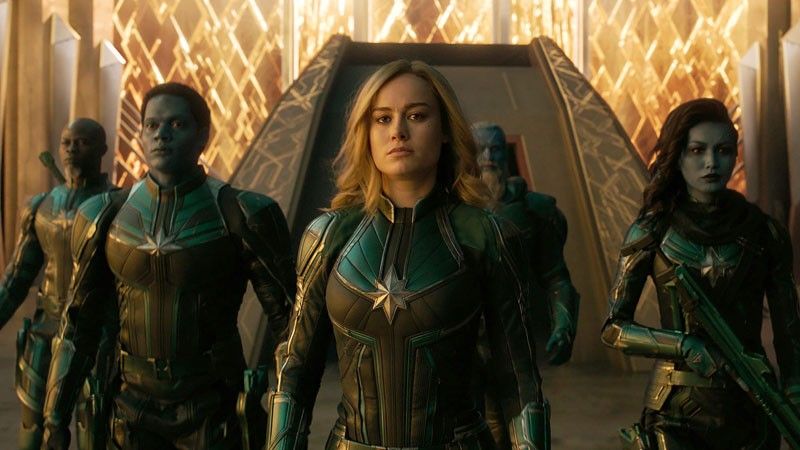
The movie begins in her Ordinary World, living as Vers on Hala and serving in the Kree StarForce. Yon-Rogg and the Supreme Intelligence emphasize to Vers that she must learn to control her powers, to make decisions with her head rather than her heart, and that her powers given by the Kree can be taken away. Yon-Rogg tells Vers he seeks to mold her into the best version of herself, and that she must defeat him in single combat on his terms as part of achieving that end. When the mission to Torfa begins, Vers fully accepts the Kree dogma that the Skrulls are an evil menace threatening the entire empire.
Though Vers experiences brief flashes from her life on Earth during dreams, her Call to Adventure does not arrive until she is captured and her memories thoroughly probed by the Skrulls’ mind-reading technology. This is the point where her journey of self-discovery could begin – except, as is typical, Vers insists upon a Refusal of the Call: “Those aren’t my memories!” Her mentor on her journey, Talos, already knows from energy signatures that there is some connection between Vers and Mar-Vell: “Then why is she in your head?” Vers breaks free and fights her way off the Skrull ship, but by the time she does the vessel has already arrived at its destination. Plummeting through the atmosphere in a disintegrating escape pod is Crossing the Threshold from the ordinary world Vers knows to the Earth where Carol is from.
The next step in Vogler’s model is called Tests, Enemies, and Allies, reflecting the trials and individuals the hero encounters on the way toward their ultimate challenges. In Captain Marvel, this spans from her crash into the Blockbuster until her arrival in New Orleans. She twice contacts Yon-Rogg, who she thinks is an ally. She pursues a Skrull on the Los Angeles subway and flees from Talos at the Air Force base, believing they are her enemy. She meets Fury, and they gradually become a team. At the Air Force base they acquire a sidekick, Goose, and are entrusted to escape by the rookie Colson. The tests Vers faces are not feats of power, but the emotional challenges of the process of self-discovery she undergoes on Earth. Realizing her StarForce uniform stands out, she steals clothes to blend in and a motorcycle for transportation. With clearer memories torn open by Talos’ probing, Vers tracks down the bar she remembers, where she convinces Fury to help her learn more about Project Pegasus. Deep within the archives, Vers uncovers truths that bring her entire understanding of her identity into doubt: the Lawson she remembers was actually Kree, and Vers herself seemingly is the test pilot who crashed with Lawson six years earlier. But Fury does not anticipate Talos replacing Keller, and they barely escape the base before she can learn more.
In Captain Marvel, the climactic beats of Vogler’s second stage of the journey are entirely emotional. Though the archive is a literal cave, the challenge of the Inmost Cave is her experiences at Maria’s home. Hearing her story, Maria asks of Vers, “is that really who are you are now?” For a character with so much confidence to this point in the film, the answer is telling: “I don’t know.” Looking through the photos and trinkets brought out by Monica, more memories return. Before she can figure things out, though, her Ordeal begins with the arrival of Talos, this time wearing his own true face. She is skeptical, but he persuades her to listen to the black box recording from the crash. At this point, just shy of two-thirds of the way through the movie’s runtime, her true memories return. She remembers the flight, the ambush, the crash, Lawson’s revelations, and the arrival of Yon-Rogg at the crash site. Taking a cue from ideas developed by DeConnick, unlike the original comics backstory where Danvers is a bystander recipient of powers when a Kree device explodes during a fight between Yon-Rogg and (male) Mar-Vell, in the movie Carol herself fires the shot that detonates the engine, giving her agency in the choice that produces her superpowers. Talos further affirms that everything she has been told by the Kree is a lie, and that the Skrulls are refugees and victims of Kree aggression whom Mar-Vell had been trying to save.
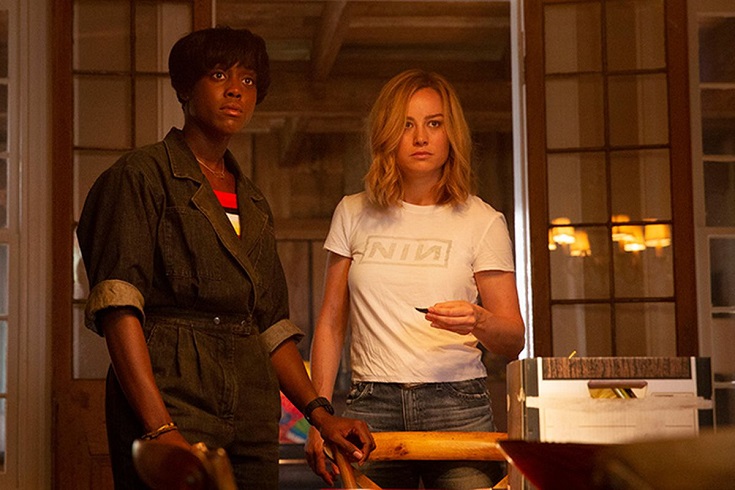
Having exposed the deception dominating her recent past, though, the heroine does not know what it means for her present or her future. Grieving and uncertain, she shouts, “I don’t even know who I am!” Talos may have guided her to the factual truth, but it is Maria who helps her reconnect with the emotional truth of who she really is: “You’re Carol Danvers,” she insists, and “you were the most powerful person I knew, way before you could shoot fire from your fists.” They embrace, signifying Carol’s acceptance of the rest of herself. Her Reward is not unlocking new powers or acquiring some magical weapon or talisman, but rather the emotional clarity that comes with the realization of her self-discovery.
The story can’t end there, of course: Carol knows Yon-Rogg is on the way, and the Skrulls need protecting from the impending Kree armada. She agrees to help Talos return to space to find Mar-Vell’s lab and, with an assist from Monica, persuades Maria to be her co-pilot. Monica also provides the first step in turning Carol Danvers into Captain Marvel when she revises the old colors of her Kree gear to the new ones. The Road Back is the reverse of her threshold crossing, returning into space to the cloaked orbital cruiser. Talos is reunited with his family and compatriots; Carol apologizes for her actions with the Kree, telling them, “I’m so sorry. I didn’t know.” Then Yon-Rogg and his forces arrive, capturing Carol and everyone else.
In Vogler’s model, the Climax stage can also be called the Resurrection, and in Carol’s case it is most definitely a rebirth. Restrained and compelled into another standoff with the Supreme Intelligence, this time the conversation goes very differently. Taunted about the supposed superiority of the Kree, she remembers standing back up each time she was knocked down. “You’re right,” she says, “I’m only human,” but she now knows with certainty that humans are strong, too. Called Vers, she balls her fists and declares, “My name is Carol.” Told once more that her powers can be taken away, she asks instead, “What happens when I’m finally set free?” Overcoming the Supreme Intelligence in her mind, Carol also breaks free of the bonds restraining her on the starship. With the control implant gone, her full power is unleashed. Carol Danvers is now fully Captain Marvel, by her own action and choice – this is the actuality of the best version of herself.
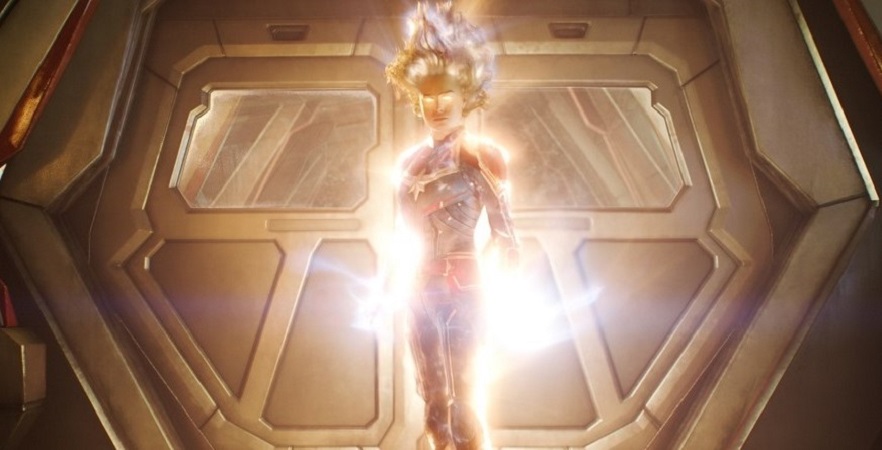
And after that emotional catharsis, the subsequent action scenes are no longer in any doubt. Captain Marvel acts as a diversion to let her friends escape. She hangs on to Yon-Rogg’s dropship as it descends toward the planet. Flung apart from it, she plummets through Earth’s sky a second time – but this time closes her eyes, centers herself, and flies smoothly back into the fight. She wrecks Yon-Rogg’s dropship, destroys the ballistic warheads, trounces the Kree fleet above Earth, and forces Ronan the Accuser into a retreat. Returning to Yon-Rogg, she allows him to bluster before blasting him across the desert. Towering over him, she declares, “I have nothing to prove to you.” Her journey of self-discovery is complete.
In the Denouement, Carol follows through on this new understanding she has reached for herself. She can make her decision with both her heart and her head. She will finish what Mar-Vell started, helping Talos and the Skrulls find a new home. She will keep her connection to Earth, too, giving Fury the enhanced pager to reach her in case of emergency. She says goodbye to Maria, knowing that her duty, at least for now, lies elsewhere. And she accepts back her flight jacket from Monica, the talisman of Carol Danvers to accompany Captain Marvel into the stars.
This Heroine’s Journey in Captain Marvel leads into the role that Carol plays in Avengers: Endgame as the culmination of a decade-long story. In the prologue sequences, she finds Tony Stark in space and returns him to Earth; none of the rest of the story could proceed without that crucial step. Questioned about why she has been absent from Earth, her rejoinder emphasizes that her sense of obligation is not limited to humankind: other planets need help, too, and they don’t have the Avengers to protect them. Five years later, Carol continues to assist in the broader galaxy as it deals with the aftermath of The Snap. When a time-traveling Thanos reappears to lay waste to the Avengers and Earth, however, Captain Marvel returns to help turn the tide, destroying his flagship and preventing him from regaining the second Infinity Gauntlet. In the epilogue, Carol stands at the back of the mourners gathered to remember Tony, present with the Avengers and their allies but not fully among them, either. With one foot on Earth and one foot in the cosmos, the MCU’s Captain Marvel no doubt has an interesting future ahead of her.
Captain Marvel is available now on home video, including DVD, Blu-ray, and 4K editions.

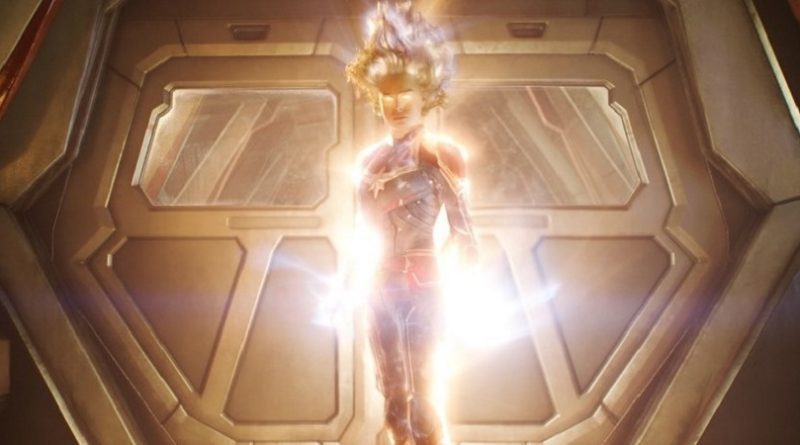








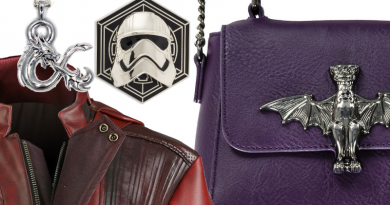

Pingback:Comparing Two Fresh Starts: Captain Marvel and Star Wars – FANgirl Blog